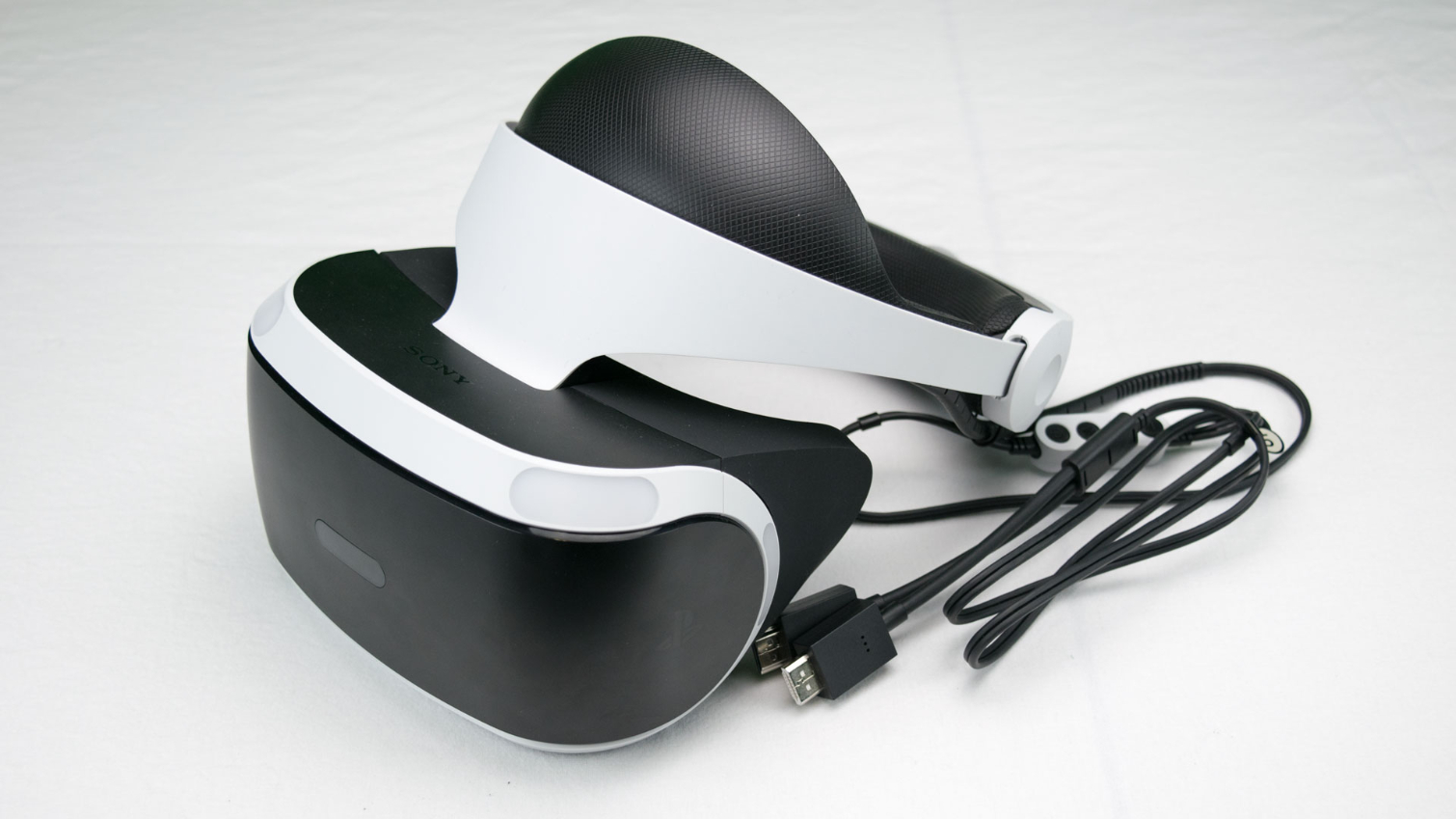Sony PlayStation VR (PSVR) Review
Why you can trust Tom's Hardware
The PSVR HMD
One of the first things you’ll notice about the PSVR is how different it is compared to the Vive and Rift. Both of those HMDs, and even OSVR’s HDK 1 and 2, feature three-point harnesses to balance the HMD's weight on your head. They rely on pressure against your face to keep the headset in place, which can be uncomfortable if you don’t adjust the straps correctly. Sony’s design instead rests the weight of the headset on your forehead.
The PSVR mounting system is more mechanical than the strap other HMDs use. There’s a halo-like ring around the top, which is adjustable for a wide range of head sizes. On the back of the ring, you’ll find a dial that locks it into place and a button to release the lock. When you press the button, you can stretch the ring to fit your head. When you get it into a comfortable position, spin the dial to lock in the right size. The dial also lets you tighten the head clasp slightly for a perfect fit.
Because of the headband mechanism, the PSVR visor doesn't rest on your face. Sony suspends the visor on a rigid mount so it hangs in front of your face. The company also includes a depth adjustment system, which makes the PSVR visor the best we’ve seen for people with glasses. The entire assembly can slide in towards your face and out away from it with the press of a button. The relief adjustment gives you just over an inch of play, so even the thickest glasses should fit without issue. Note that the relief mechanism is not a hinge, though we wish it was. A lot of strain is placed on the adjustment mechanism if you hold the visor while you tweak the headset's angle. This adjustment point may prove to be a weak spot.
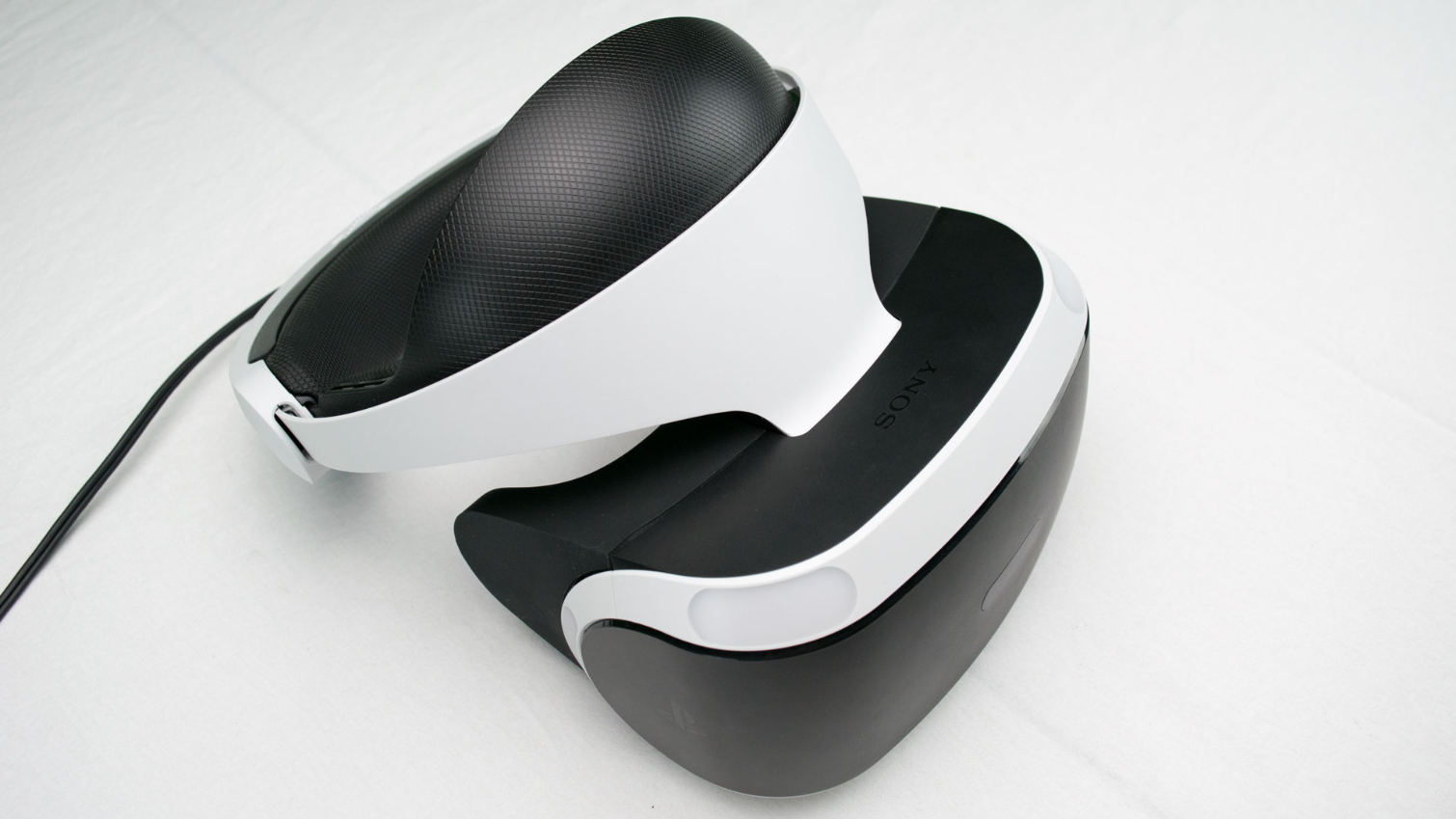
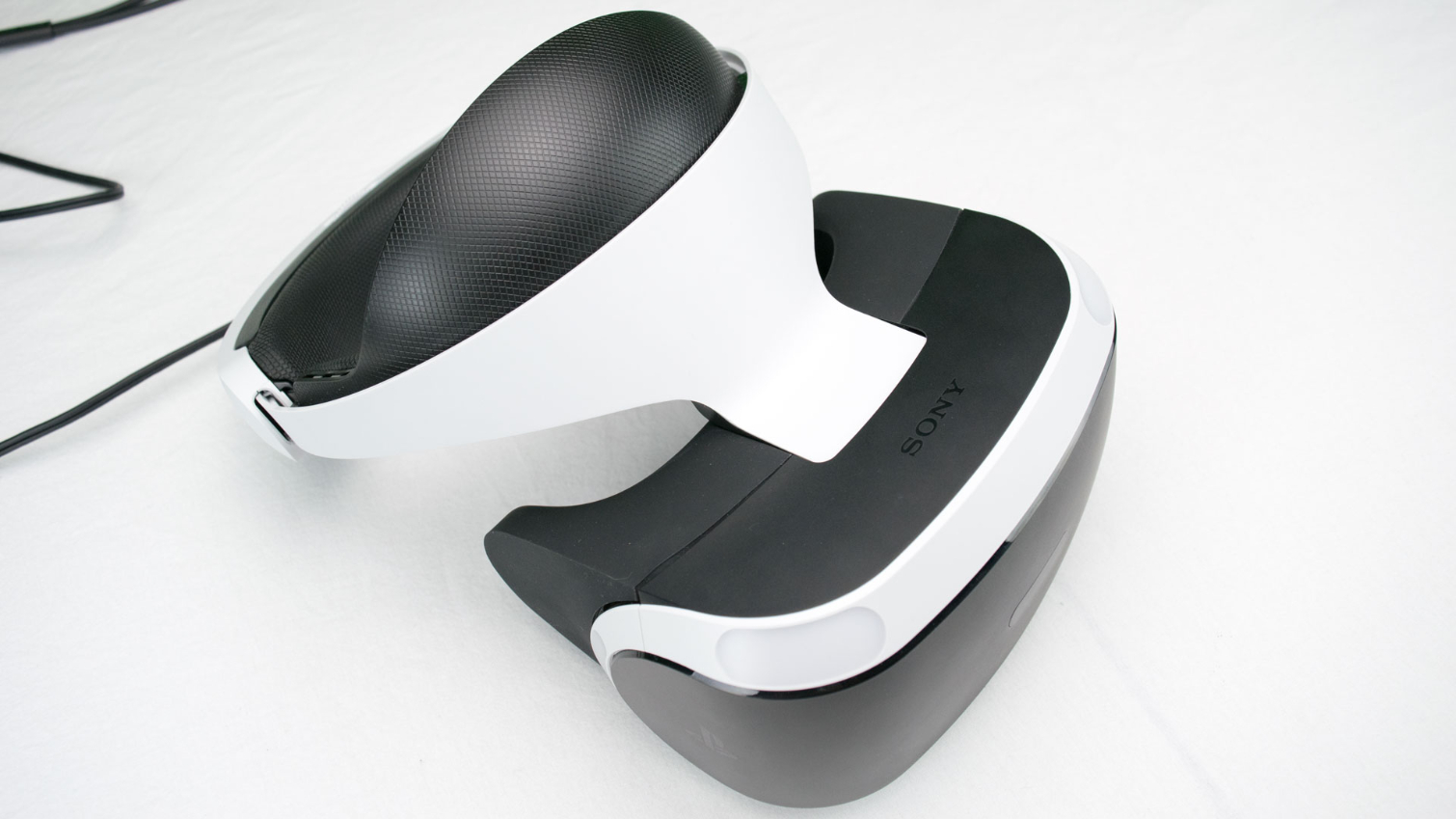


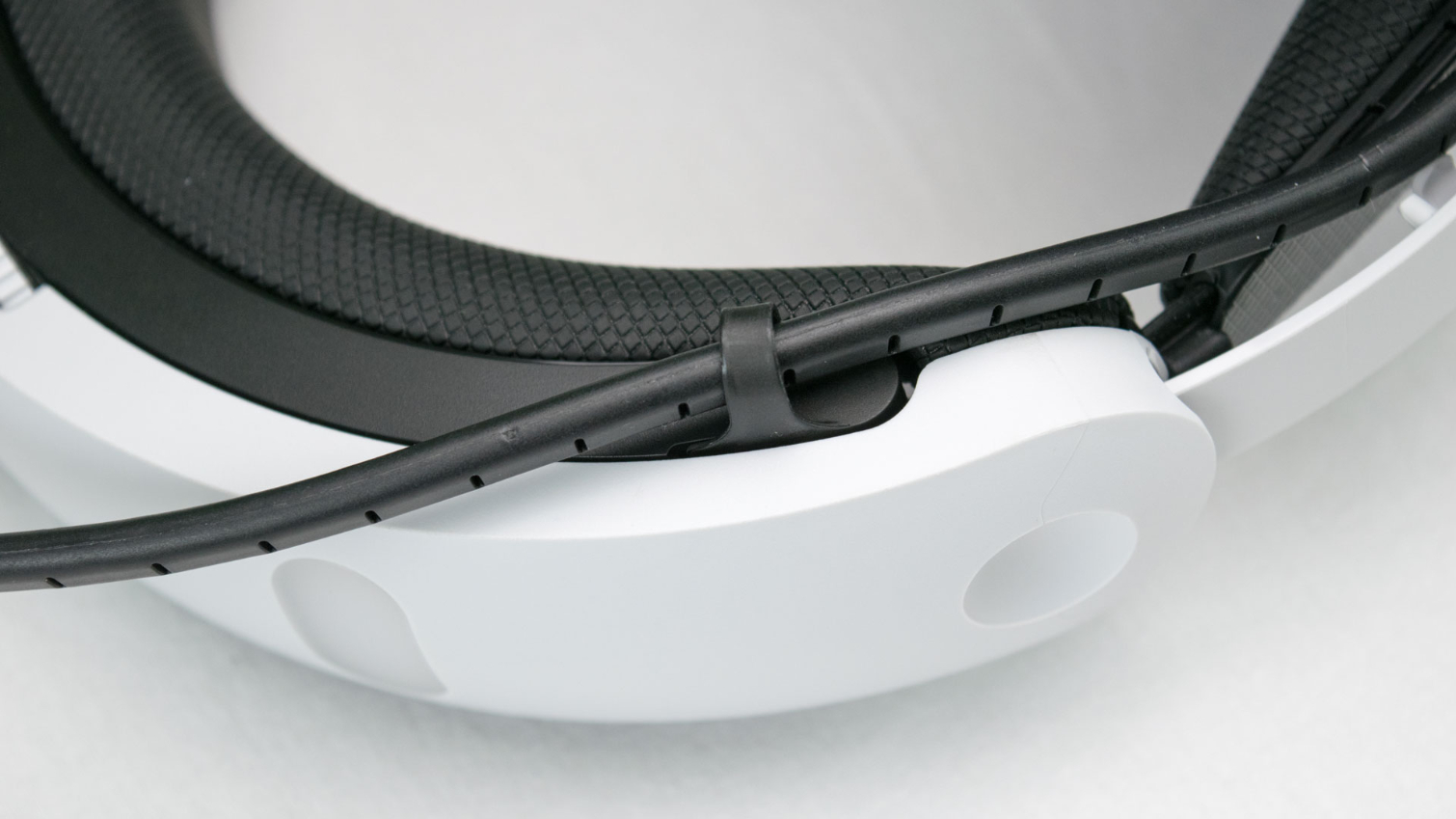
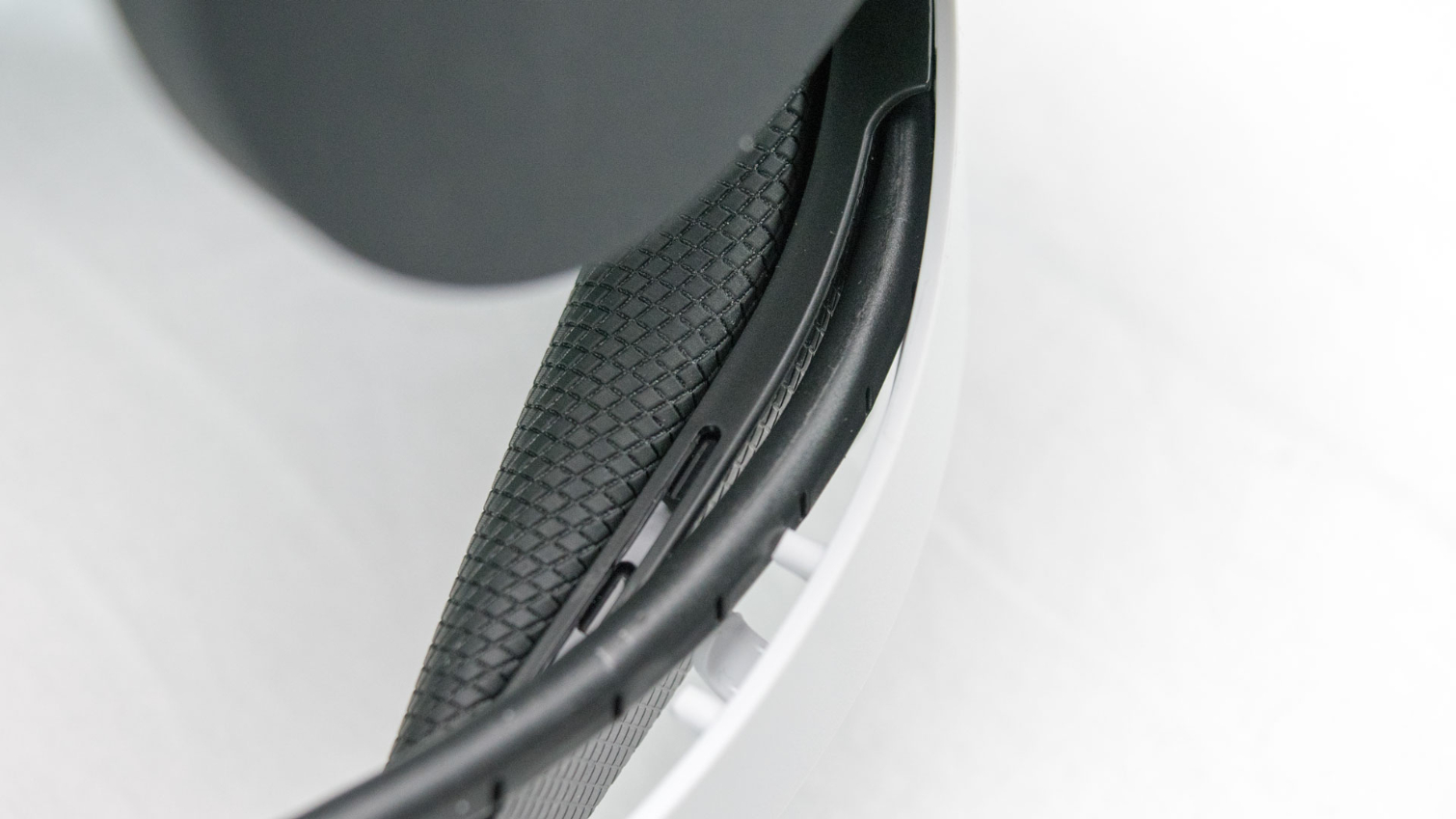


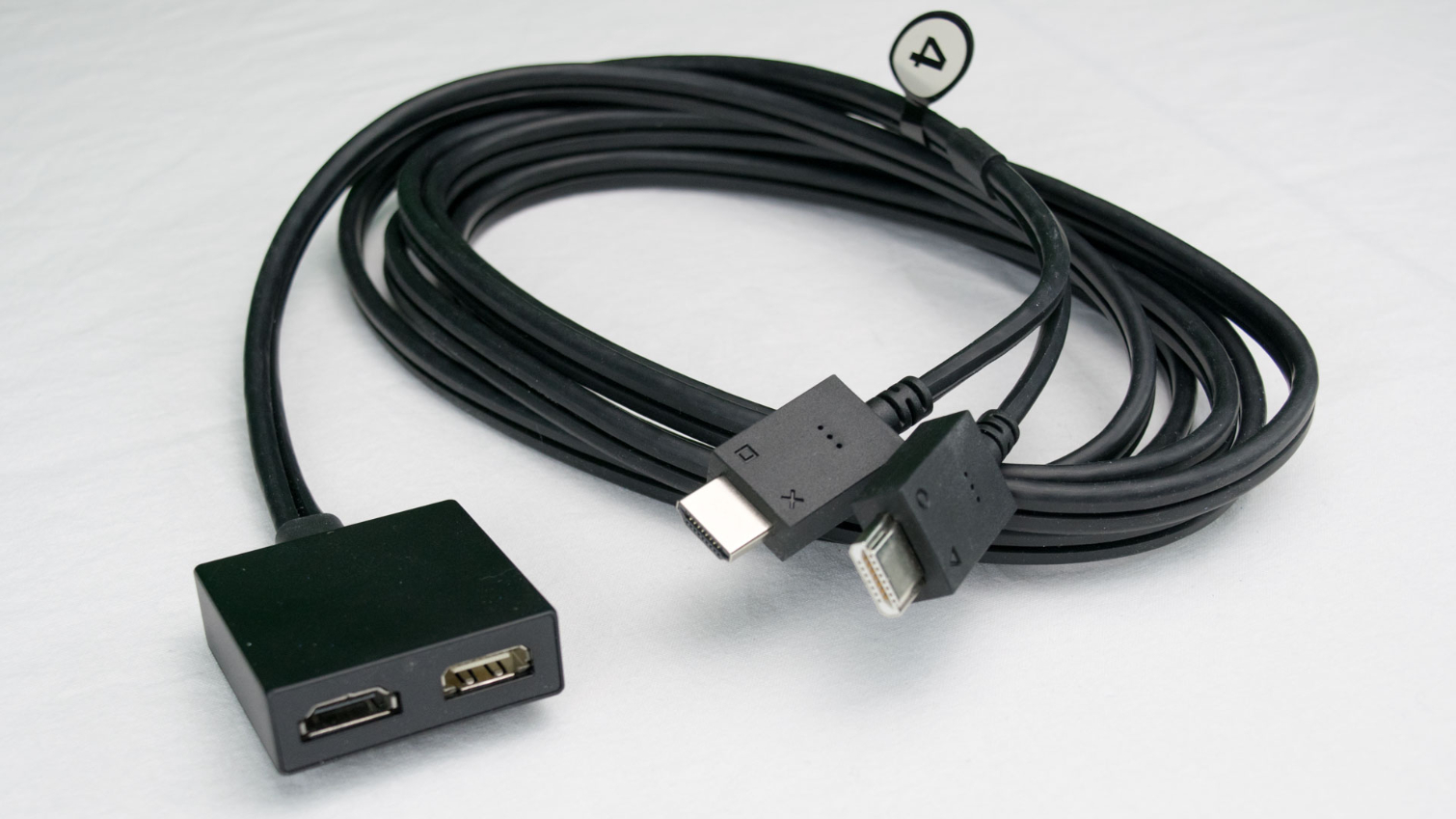

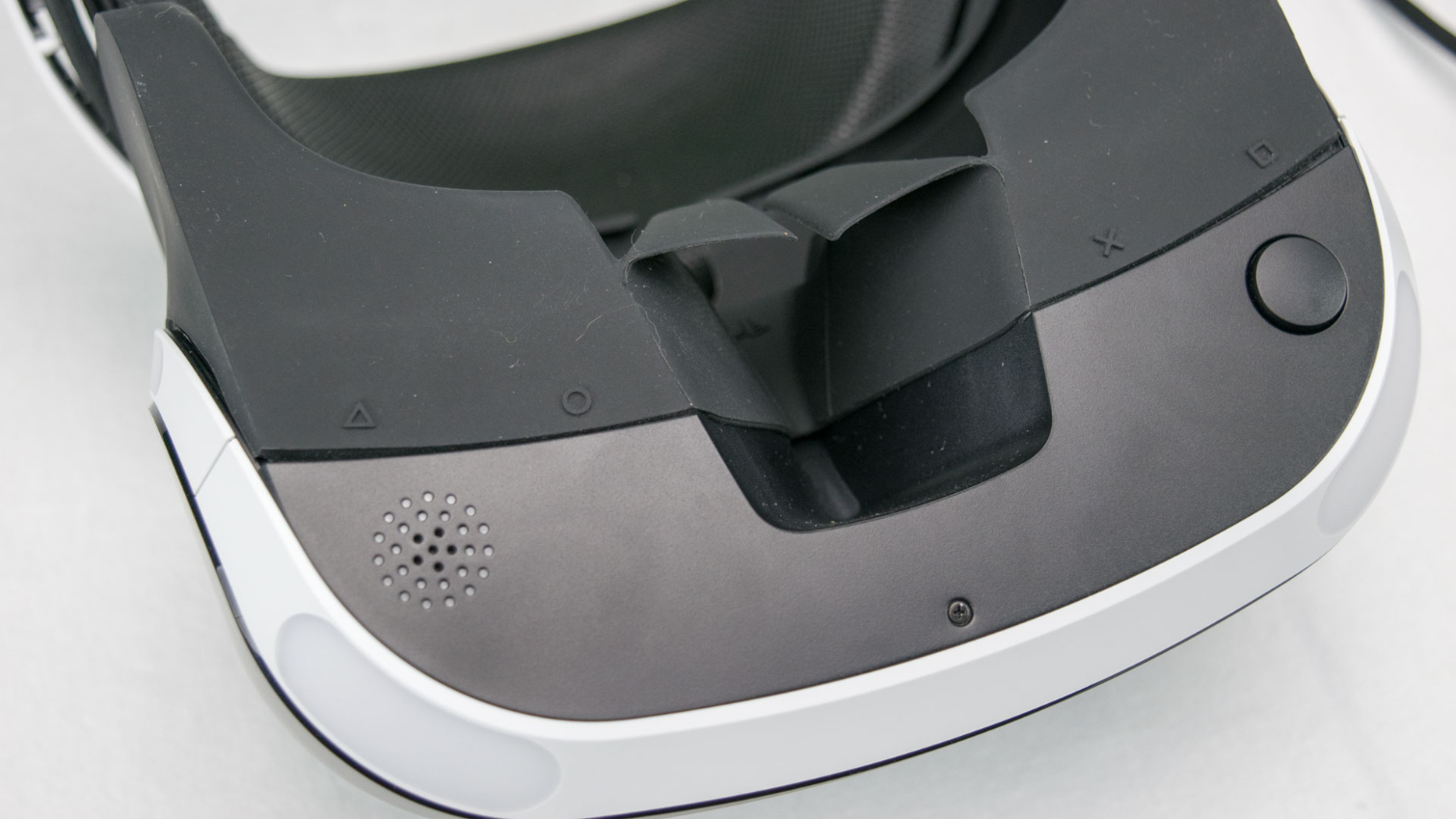
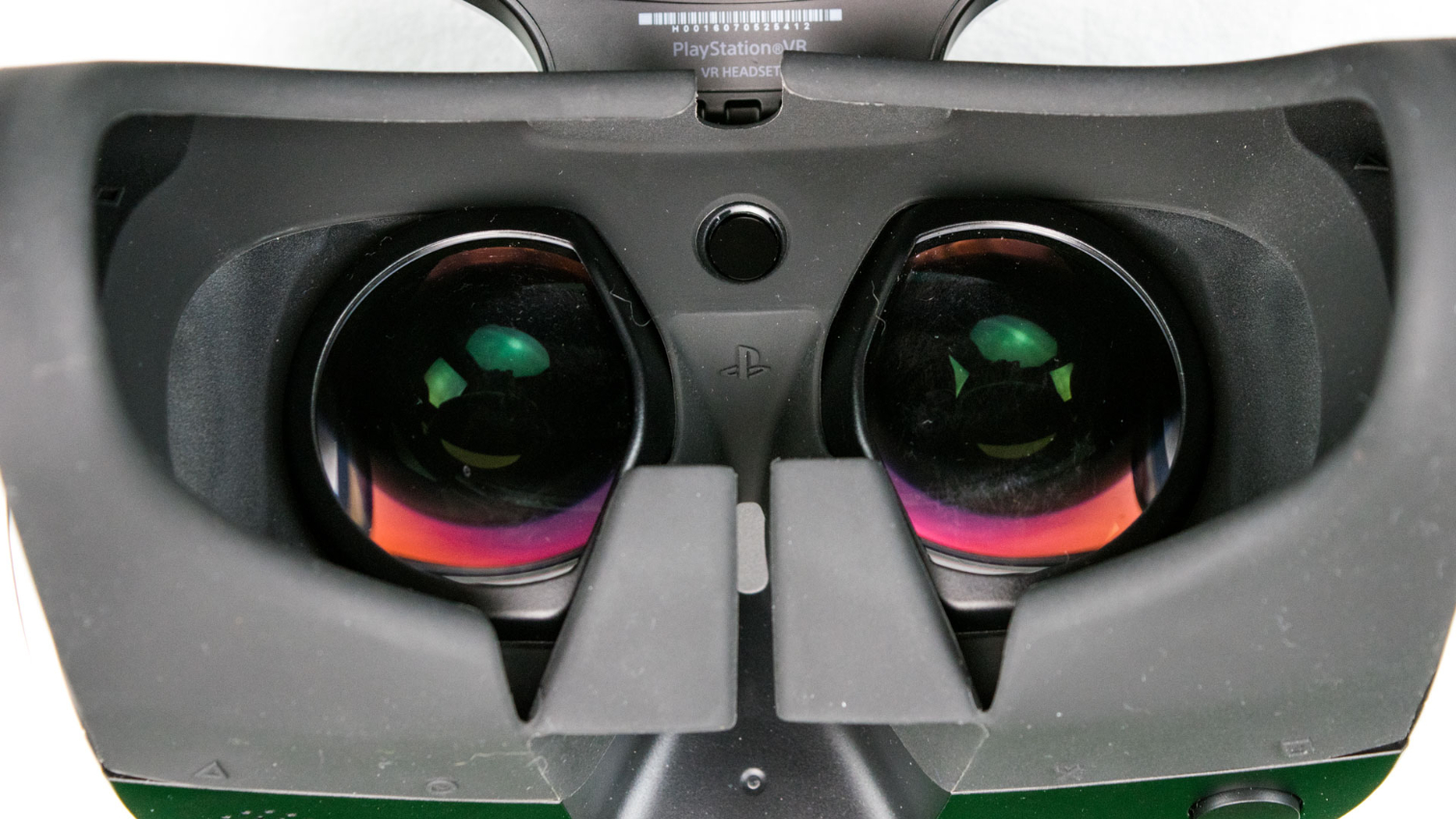
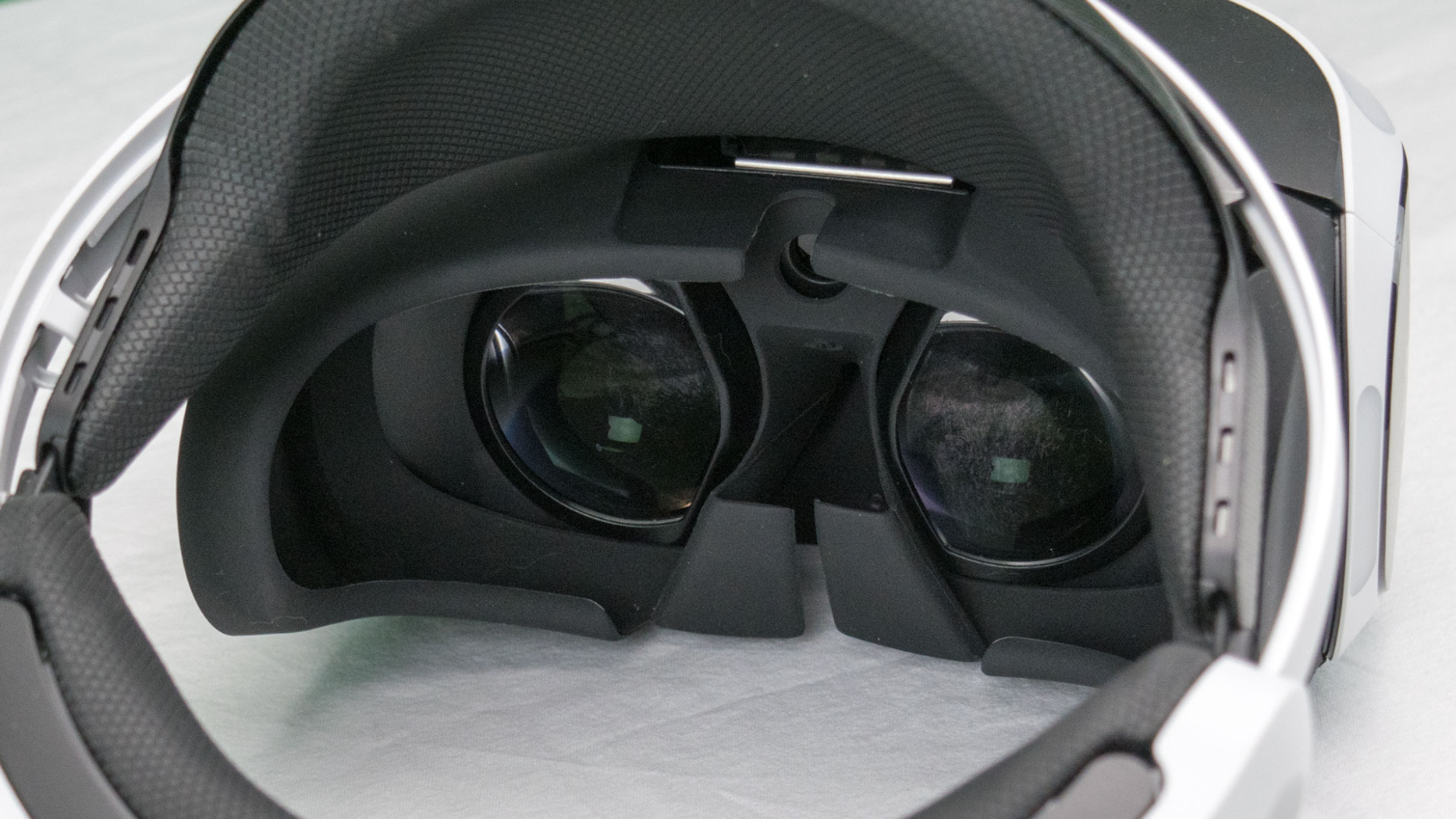
The halo headband is padded on the front so that it rests comfortably on your forehead, and it’s padded on the rear where it clamps down on your head. You can’t remove the foam to replace or clean it, but Sony wraps it in a rubberized, moisture-resistant material that you can quickly and easily wipe off.
Unlike most VR HMDs, the PSVR doesn’t rely on a foam gasket to keep light from bleeding in. Because the headset isn't tight against your face, a gasket would be of little use anyway. Sony instead uses a soft rubber flap that conforms to the shape of your glasses, if necessary. And if the rubber is somehow too restrictive, you can easily remove it and still use the headset, although not to the same level of immersion.
There's a hard-wired five-foot-long cable that comes out of the left side of the head strap. Sony reinforces the first 10 inches of the cable with thicker rubber coating that's notched to dictate the direction of flex. The extra reinforcement prevents the cable from getting pinched enough to damage it.
This is the only headset we’ve seen with an inline power button, which is handy. Approximately 18 inches down the cord from the HMD, you’ll find a control box that includes volume up, volume down, mute, and power buttons for the HMD. As a result, you don't have to unplug the headset if you want to switch back to gaming on your TV.
Get Tom's Hardware's best news and in-depth reviews, straight to your inbox.
The end of the PSVR’s data cable splits into two plugs: an HDMI connector and a proprietary interface that carries data from the PlayStation to the HMD. Sony also includes 10-foot extension cable so that you can sit on your couch with the headset on. The extension cable isn’t technically necessary, but five feet isn’t a lot of slack to work with. If you sit close enough to your console for the basic cable to reach, you may have a hard time positioning the tracking camera (more on that later).
Speaking of tracking, PSVR uses the same system as the Move and DualShock 4 controllers. Sony uses the PlayStation Camera to track the headset's position and orientation via blue LEDs in nine strategic positions. There are lights in each corner on the front of the HMD and one in the center. You’ll also find a light on the left and right sides, and two more on the back of the headband. In addition to its LED tracking system, the headset features a three-axis gyroscope and a three-axis accelerometer to detect motion.
A Special Display
The Rift and Vive both feature dual 1080x1200 displays (one for each eye), and they operate at 90Hz, requiring 90 FPS or more from the graphics subsystem. Sony designed the PS4 for gaming at 1080p (and lower), and often at 30 FPS. Most people think 1080p isn’t a high enough resolution for VR, so going any lower for PSVR wasn't an option. Sony wants its VR platform to appeal broadly. To achieve this, it had to make the experience as comfortable as possible. So a lower refresh rate wasn't an option either, given all of the research we've seen from Oculus and Valve indicating its impact on comfort.
A 2160x1200 resolution and 90Hz refresh rate are the two main reasons you need a fast graphics card for PC-based VR. The GPU inside Sony's PS4 is powerful, but unless you have a PS4 Pro, it doesn't hold a candle to modern high-end graphics cards. Instead of forcing game developers to target 90 FPS on fairly mainstream hardware, Sony took a different approach.
Its display can operate at 90 or 120Hz, and devs are free to aim for either target. If a game will run at 90 FPS, the display refreshes at 90 Hz. Of course, 1080p at 90Hz is tough for a console, potentially limiting the experiences created for PSVR. Sony gets past this problem by implementing reprojection technology, allowing developers to optimize for 60 FPS. The console then reprojects every other frame, effectively doubling the frame rate to 120 FPS, in which case the PSVR runs at 120Hz.
Sony uses a 960x1080-per-eye resolution for the PSVR’s panels. But the company also takes advantage of its RGB subpixel OLED technology to overcome any perceived image quality disadvantage. Whereas the Rift and Vive require three pixels to create colors, Sony can reproduce any color with every individual pixel, yielding crisper colors than a traditional subpixel display. The Rift and Vive almost seem washed out in comparison.
More Company Synergies
Sony tapped the same experts who design optics for its SLR cameras to create specialized lenses for the HMD. We’re not sure what kind of lenses the PSVR employs, but we can’t see any visible stepping marks in them, which means they aren’t Fresnel lenses. Even the Rift, with its hybrid-Fresnel lens design, shows visible lines if you look at the lens, not through it. The PSVR’s lenses don’t appear to be fisheyes either. Sony’s implementation is crystal clear throughout.
| PlayStation VR Specifications | |
|---|---|
| Display Type | Single low-persistence OLED (RGB subpixel) |
| Display Size | 5.7-inch |
| Resolution | 1920x1080 (960x1080 per eye) |
| Refresh Rate | 90Hz, 120Hz |
| Field of View | ~100-degrees |
| Lens Type | Unknown |
| Lens Adjustment | Digital IPD adjustment, lens-to-eye distance |
| Sensors | Three-axis accelerometer, three-axis gyroscope |
| Tracking Technology | Six-degrees-of-freedom LED camera tracking |
| Integrated Camera | No |
| Audio | Microphone, in-line 3.5mm audio jack |
| HMD Ports | Proprietary headset connector (HDMI/proprietary plug) |
| HMD Cable Length | Five-foot tethered HMD cable, 10-foot extension cable |
| Materials Used | Plastic, glass, foam rubber, rubber |
| VR Headset Dimensions (WxHxL) | Approx. 187x185x277mm (Headband at shortest length) |
| Processor Unit Dimensions (WxHxL) | Approx. 143x36x143mm |
| Weight | 610g (excluding cable) |
Kevin Carbotte is a contributing writer for Tom's Hardware who primarily covers VR and AR hardware. He has been writing for us for more than four years.
-
blackmagnum Sony going after the affordable market? You've got to be kidding me! What's Apple say on this?Reply -
bit_user Thanks for the thorough review, Kevin. Is OSVR's HDK2 in your queue? I understand it has display tech similar to PSVR's, but with the same pixel resolution as Rift & Vive.Reply
If I buy PSVR, I'd wait for PS4 Pro to get updated so the breakout box is unnecessary. They should've just put the PSVR ports right on the front of it. Then, sell me the whole kit in one box.
As for the lack of room scale, it's hardly surprising, if they're just using the stereo camera for tracking. It has to be able to see the controllers, which it can't do if your body is in the way. Even if they have built-in IMUs, those will drift without periodic registration with the camera.
Finally, I'm impressed that it can send different images to the HMD and TV. Although this will only add to the burden on the PS4's GPU, it's a nice feature. Reminds me of the Wii U, a bit. I don't own one, but saw a couple games make good use of the private view afforded by the tablet. -
Dosflores Reply19196429 said:Finally, I'm impressed that it can send different images to the HMD and TV. Although this will only add to the burden on the PS4's GPU, it's a nice feature.
It doesn't necessarily add burden on the GPU. It's only needed for "social gaming", and that kind of games can live without great graphics. For "standard games", the breakout box simply undistorts the image being sent to the HMD, and outputs the result to the TV.
You're right about the PS4 Pro. It should have included the PSVR ports, and not only to reduce clutter. The PS4 Pro supports HDR output (and the standard PS4 now does it too), but the breakout box doesn't. If you want HDR output to your TV, you have to disconnect the breakout box and connect the PS4 directly to the TV. If you want to play some VR game again, you have to disconnect the TV and connect the PS4 to the breakout box again. This design flaw is enough to convince me not to buy PSVR until the next update of either the PS4 Pro or the PSVR system. -
cknobman You did not touch on the actual gaming experience very much.Reply
I read and watched a few game experiences and reviews using PSVR and the biggest complaint that was due to how low the processing power was of the PS4 they had to really really compromise on the graphics.
The graphics of the VR games on PS4 were absolutely terrible including missing/no textures lots of things just not rendered period and low res up-sampled. -
Agente Silva ... and I´ll explain why:Reply
1. In an era where game developers are heading into unified platforms it will be very hard to see proper games (instead of "experiences").
2. Gamers don´t want to have a strapped screen to their face.
3. Enthusiasts won´t spend 500$ on something that doesn´t display AAA games (not even mentioning mainstream).
4. For the mainstream this is a showroom equipement. -
Jeff Fx >Premium-grade virtual reality demands more performance than you would expect a PS4 could provideReply
Yes it does.
>, but Sony pulls it off.
No, this is PSVR, which is far from a premium VR experience.
They can't deliver the tracking accuracy or video quality of a premium VR system. -
kcarbotte Reply19196429 said:Thanks for the thorough review, Kevin. Is OSVR's HDK2 in your queue? I understand it has display tech similar to PSVR's, but with the same pixel resolution as Rift & Vive.
If I buy PSVR, I'd wait for PS4 Pro to get updated so the breakout box is unnecessary. They should've just put the PSVR ports right on the front of it. Then, sell me the whole kit in one box.
As for the lack of room scale, it's hardly surprising, if they're just using the stereo camera for tracking. It has to be able to see the controllers, which it can't do if your body is in the way. Even if they have built-in IMUs, those will drift without periodic registration with the camera.
Finally, I'm impressed that it can send different images to the HMD and TV. Although this will only add to the burden on the PS4's GPU, it's a nice feature. Reminds me of the Wii U, a bit. I don't own one, but saw a couple games make good use of the private view afforded by the tablet.
I'm glad you enjoyed the review. OSVR HDK2 is on my list. I hope to have a review sample in the near future.
I was also suprised/impressed that it could do social screen gaming when I first hear about it. Check out my interview with Richard Marks (linked in the review) for more insight on that.
-
kcarbotte Reply19198130 said:You did not touch on the actual gaming experience very much.
I read and watched a few game experiences and reviews using PSVR and the biggest complaint that was due to how low the processing power was of the PS4 they had to really really compromise on the graphics.
The graphics of the VR games on PS4 were absolutely terrible including missing/no textures lots of things just not rendered period and low res up-sampled.
I wrote the review before the PS4 Pro launched but it was delayed due to the Rift review, holiday break, and CES. At the time of writing the review, I hadn't had a chance to try many games. Sony didn't provide us a review sample, so I purchased all the games that I have.
I've since updated to the PS4 Pro and picked up a number of games. Watch for follow-up content about some games soon. -
kcarbotte Reply19198536 said:... and I´ll explain why:
1. In an era where game developers are heading into unified platforms it will be very hard to see proper games (instead of "experiences").
Care to elaborate? I'm not following your logic here.
Unity and Unreal make it easy for developers to support Oculus, SteamVR, and PSVR with minimal effort.
19198536 said:2. Gamers don´t want to have a strapped screen to their face.
That's an incredibly generalzed, and ill-informed statement. Sony stated it sold "many hundred of thousands" of PSVR headsets upon release and the hardware has been in high demand to the point where Sony has not been able to keep up with demand. Its sold out practically everywhere.
In my experience, after showing over 3000 people VR hardware, people think they don't want to strap on a screen until they try it, and then they want one of thier own.
19198536 said:3. Enthusiasts won´t spend 500$ on something that doesn´t display AAA games (not even mentioning mainstream).
Resident Evil 7 drops tomorrow with full VR support start to finish.
Robinson: The Journey is easily a AAA title.
AAA titles are coming. It takes time to make AAA games, though. Many games take 2 to 3 years or more to develop. Sony hasn't had developer kits of PSVR out in the wild for that long.
19198536 said:4. For the mainstream this is a showroom equipement.
Yup. That's how new technology launches.
When CDs hit the market in the 80s, DVD players were thousands of dollars.
When PCs hit the market, they were well over $5000
When Cell Phones came to market, they were thousands of dollars with no subsidies.
I could go on and on and on all day long about new technologies launching at crazy prices.
Early adopters always pay a higher price to be first in line. As units sell in higher and higher volume, manufacturing costs come down, which leads to lower consumer price tags.
VR hardware won't always be $500.
